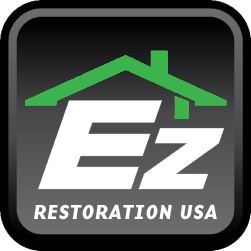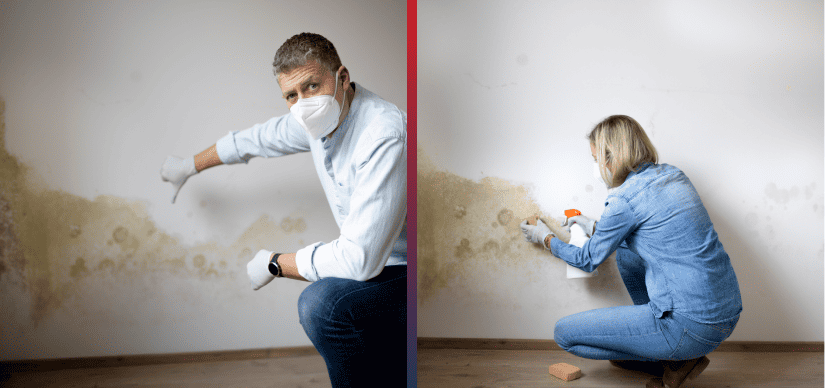How to Get Rid of Mold on Painted Walls?
Understanding Mold Removal from Walls
Common reasons why mold appears on painted walls:
Moisture: Excess moisture is the primary catalyst for mold growth. This moisture can come from various sources, such as leaks in plumbing, roofs, or walls, high humidity levels, condensation, or flooding. When moisture seeps into the walls, it creates an ideal environment for mold to thrive, especially in porous materials like drywall.
Poor Ventilation: Inadequate ventilation prevents proper airflow and moisture evaporation, leading to the accumulation of dampness in confined spaces such as bathrooms, kitchens, or basements. Without proper ventilation, moisture becomes trapped, creating conditions favorable for mold growth.
Water Damage: Water damage, whether from leaks, floods, or plumbing issues, can saturate walls and ceilings, providing ample moisture for mold colonization. Even minor water intrusion over time can lead to mold growth behind walls or in hidden spaces. Hence, DIY mold removal or professional assistance is recommended.
Condensation: Areas with high humidity levels, inadequate insulation, or temperature differentials can experience condensation buildup on painted walls. Condensation occurs when warm, moist air comes into contact with cooler surfaces, leading to water droplets forming on the walls. This moisture encourages mold growth over time.
Organic Matter: Painted walls contain organic materials such as cellulose from drywall or wood, which serve as food sources for mold. If these materials become damp or wet, they provide nutrients for mold spores to feed on and proliferate.
Signs of Mold on Painted Walls:
Visible Mold Growth: The most obvious sign of mold on painted walls is the presence of dark or discolored patches. Mold can appear as black spots, greenish or brownish fuzz, or even white specks. These patches may spread over time if left untreated.
Musty Odor: Mold often emits a musty, earthy odor, particularly in areas with significant mold growth. If you notice a persistent musty smell in a room or near painted walls, it could indicate hidden mold behind the walls or within the wall cavities.
Peeling or Discoloration: Painted walls affected by mold may exhibit signs of deterioration, such as peeling, bubbling, or blistering paint. Mold growth can cause the paint to lose adhesion and peel away from the surface, revealing the underlying mold colonies. Therefore, try to get the best mold-cleaning solution.
Allergic Reactions: Exposure to mold spores can trigger allergic reactions in sensitive individuals. Symptoms may include respiratory issues, coughing, sneezing, itchy eyes, and skin irritation. If you or your family members experience unexplained health issues that improve when leaving the affected area, mold exposure could be the cause.
Water Stains: Water stains on painted walls can indicate previous water damage or ongoing moisture issues, which create favorable conditions for mold growth. Even if mold is not visible, water stains should be addressed promptly to prevent mold infestation.
How to Remove Mold From Painted Walls: An Ultimate Guide
1. DIY mold removal methods:
Hydrogen Peroxide Solution: Understand the ingredients required, like 3% hydrogen peroxide, Water, Spray bottle, Brush or sponge, and Protective gloves and mask (optional).
Steps:
- Mix equal parts of 3% hydrogen peroxide and water in a spray bottle.
- Spray the solution directly onto the moldy areas, ensuring thorough coverage.
- Let the solution sit for 10 to 15 minutes to penetrate the mold.
- Using a brush or sponge, scrub the moldy areas to loosen the mold from the surface.
- Wipe clean with a damp cloth or sponge to remove the mold residues.
- Rinse the walls with clean water and allow them to air dry completely.
Tea Tree Oil Solution: The ingredients used to prepare tea tree oil solution are tea tree oil, water, spray bottle, cloth or sponge, and protective gloves (optional).
Steps:
- Dilute tea tree oil with water in a spray bottle (about 1 teaspoon of tea tree oil per cup of water).
- Shake the bottle well to mix the solution thoroughly.
- Spray the tea tree oil solution directly onto the moldy areas.
- Allow the solution to sit for at least an hour to effectively kill and loosen the mold.
- Using a cloth or sponge, scrub the moldy areas to remove the mold residues.
- Wipe the walls clean with a damp cloth or sponge.
- Let the walls air dry completely.
Grapefruit Seed Extract Solution: The following ingredients are used to prepare the solution: grapefruit seed extract, water, spray bottle, cloth or sponge, and Protective gloves (optional).
Steps:
- Mix 10 drops of grapefruit seed extract with one cup of water in a spray bottle.
- Shake the bottle well to ensure thorough mixing.
- Spray the solution onto the moldy areas, covering them completely.
- Let the solution sit for 10 to 15 minutes to penetrate the mold.
- Use a cloth or sponge to scrub the moldy areas and remove the mold residues.
- Wipe the walls clean with a damp cloth or sponge.
- Allow the walls to air dry completely.
2. Getting professional assistance:
Years of Experience: Mold remediation experts have specialized training and experience in identifying, assessing, and effectively treating mold infestations. They understand the behavior of different types of mold and know how to address specific issues based on the extent of the infestation and the underlying causes.
Comprehensive Assessment: Professional mold removal services begin with a thorough inspection and assessment of the affected areas. They can identify hidden mold growth behind walls, in crawl spaces, or in other inaccessible areas using advanced techniques such as moisture meters and thermal imaging cameras. This ensures that all sources of mold contamination are identified and addressed.
Advanced Equipment and Techniques: Mold remediation professionals have access to advanced equipment and tools that are not typically available to homeowners. This includes high-efficiency particulate air (HEPA) filtration systems, negative air machines, dehumidifiers, best mold and mildew remover, and specialized cleaning solutions. These tools allow them to effectively remove mold spores from the air and surfaces, ensuring thorough remediation.
Safe and Effective Treatment: Professional mold remediation services prioritize the safety of occupants and the integrity of the property. They follow industry best practices and safety protocols to contain the mold, prevent cross-contamination, and minimize exposure to harmful mold spores. They also use environmentally friendly and non-toxic cleaning solutions to eliminate mold without posing health risks to residents.
Prevention of Recurrence: In addition to removing existing mold growth, professional mold remediation services focus on addressing underlying moisture issues and implementing preventive measures to prevent mold recurrence. This may include repairing leaks, improving ventilation, and applying mold-resistant coatings to surfaces. By addressing the root causes of mold growth, professionals help minimize the risk of future mold problems.
Hassle-free: Hiring professional mold remediation services provides homeowners with peace of mind, knowing that the job will be done thoroughly and safely. Professionals take care of all aspects of mold removal, from initial assessment to final cleanup, allowing homeowners to focus on other priorities without worrying about the mold problem.
3. Preventive Measures:
- Improve ventilation in areas prone to moisture buildup.
- Repair any leaks or water damage promptly.
- Use mold-resistant paint or additives when repainting walls.
- Keep indoor humidity levels below 60%.
- Regularly inspect and clean areas susceptible to mold growth.
Why Hire EZ Restoration USA?
Hiring the best mold removal company ensures thorough, safe, and effective remediation of mold issues. With expert knowledge, advanced equipment, and years of experience, they can accurately assess the extent of mold growth, address underlying causes, and employ specialized techniques to eradicate mold while minimizing health risks.
Their meticulous approach and attention to detail not only ensure complete removal but also prevent recurrence, protecting the integrity of your home and the health of your family. Trusting the best mold removal company guarantees peace of mind, knowing that your property is in capable hands and will be restored to a mold-free environment efficiently.
Removing mold from painted walls requires diligence, proper techniques, and sometimes professional assistance. By employing DIY methods or enlisting the help of mold removal services, you can effectively eliminate mold infestations and safeguard your home against future outbreaks.
Remember to address underlying moisture issues and implement preventive measures to maintain a mold-free environment.


